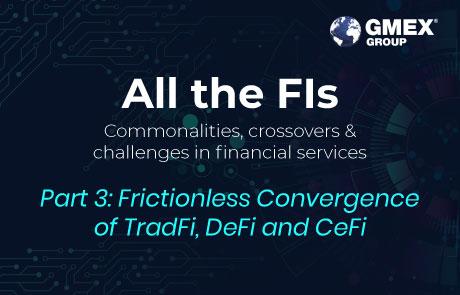Part 3 – Frictionless convergence of TradFi, DeFi and CeFi
The financial markets digital transformation journey is definitely gaining momentum. As the pace of digital transformation accelerates, it is important to remove friction between the ‘moving parts’ (and players).
Achieving real utility, and bringing in more assets from new users in all countries requires DeFi to build real bridges to the CeFi world. Instead of viewing these as competing Fis, we need to consider how we utilise DeFi to create sustainable long-term value in the three most essential buckets for adoptions: crypto assets, tokenized gold, stablecoins and real-world assets such as digitized carbon credits. DeFi projects need a more customer-centric balance between financial utility and decentralized protocol; it has to ensure that investors feel safe onboarding into these assets.
A HyFi (hybrid) infrastructure can help to unlock potential, offering the ability to enter new regions and territories, to comply with local requirements and regulations, to test new strategies and products in a commercially viable way, and at the same time to take a more granular approach to risk identification. It’s the AWS/Amazon mindset – experiment with real assets, take chances, develop more, more proactively, without undue risk and cost. The whole notion of digitisation and automation optimisation is critical to understand; at the same time it’s important to weigh the cost-benefit analysis of what can be delivered today, versus what can be delivered tomorrow, or in the next sprint. On the evolving digital transformation journey, APIs are going to be really important.
Blockchain is just a tool, albeit a tool that needs to be considered as part of a digitisation or modernisation strategy, ideally on the back of a top-down mandate. Of course, it isn’t necessary to run a blockchain to access digital assets. For example, Invesco has announced the creation of exchange-traded Bitcoin products with underlying custody maintained with a digital custodian (e.g. Zodia Markets), but with a ‘wrapper’ that makes it look and feel like a traditional securities product. As such, the product can be listed on traditional, as well as digital, exchanges; and why shouldn’t you be able to do both?
7 or so years down the line in blockchain knowledge and experience, financial institutions developing products and services are realising that these need to include rigorous security models. From the perspective of speed, in terms of time to market and market velocity itself, security has to be API-driven. Using the AWS analogy again, every AWS process is driven by APIs. Given the rapid evolution of Amazon from online bookseller to what it is today, it is easy to accept this business imperative for infrastructure modernisation.
Historically, security has been something of an afterthought in the product development process. The traditional view tends to be that you build the product, ship it, and then think about securing it. One of the key things we can learn from blockchain is to define the security strategy on day one of the digital transformation journey. Regardless of whether that strategy includes blockchain technology, incorporating the security piece at the outset will result in a more robust ecosystem. It’s not just about a product or service, it’s also the creation of an effective governance structure for interactivity between counterparties, and internal and external stakeholders.
Just a short while ago, if we had asked most financial institutions to describe what Web 3.0 looked like, the predominant perception would have been that it was about private blockchains. Now that more of them have ‘lifted the hood’ and looked more closely at it, they will more likely conclude that it will be a mixture of public and private blockchains. They are also more likely to agree that there is a need for some level of TradFi/DeFi infrastructural integration, for example with FIX trading protocol, or SWIFT MQ for post-trade processing, or traditional API technologies, none of which, with their associated constructs, are going away any time soon.
“The key is understanding the opportunity to leverage existing business, and to bridge the gap between traditional financial, commodities and carbon credits markets and the parallel universe of digital assets and technologies by partnering or investing in the missing components.”
The bridge between traditional finance and DeFi will be technology-driven, and will provide an opportunity for sustainable finance initiatives to scale and harness new forms of distribution. While there is still a lot of work to do until the first institution is comfortable to announce that it will place 20% of its assets under management on a distributed ledger, there is no doubt that the mindset of the finance industry is changing, and that banks and institutions are moving – albeit slowly – towards accepting and ingraining digital technologies within modernisation strategies.



